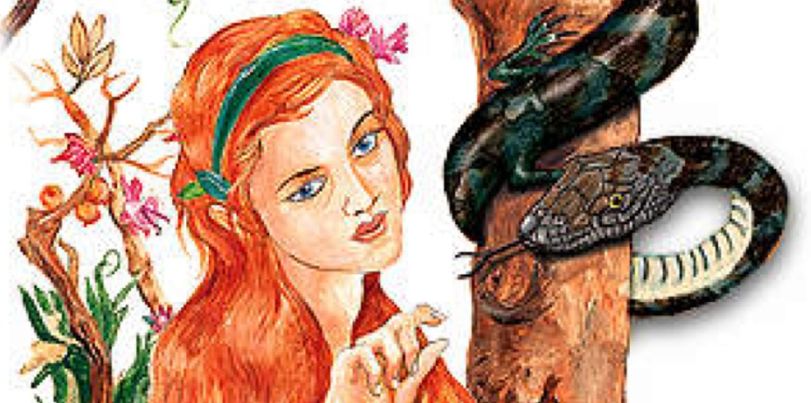 This Hmong folktale is full of broken promises. Three times a widow breaks a promise that whoever removes a large rock from her field can marry one of her daughters. Each time the rock is returned. She finally relents and agrees that the mystery helper (a huge, shape-shifting snake), can marry her daughter “Pumpkin Seed”. Later, over three nights, she breaks a promise to Pumpkin Seed that she will kill the snake while it is sleeping. Forced to accompany the snake to its home, Pumpkin Seed proves just as untrustworthy as her mother before unexpectedly living “Happily Ever After”. More…
This Hmong folktale is full of broken promises. Three times a widow breaks a promise that whoever removes a large rock from her field can marry one of her daughters. Each time the rock is returned. She finally relents and agrees that the mystery helper (a huge, shape-shifting snake), can marry her daughter “Pumpkin Seed”. Later, over three nights, she breaks a promise to Pumpkin Seed that she will kill the snake while it is sleeping. Forced to accompany the snake to its home, Pumpkin Seed proves just as untrustworthy as her mother before unexpectedly living “Happily Ever After”. More…
Category Archives: Folktales, Legends & Myths
Gombei and the Wild Ducks
 In this Japanese folktale retold by Yoshiko Uchida, a man who had made a good living by snaring one wild duck a day with a long piece of rope decides that life would be easier if he were to trap a hundred at a time and relax for the next ninety-nine days. He learns a lesson that changes his life when, having caught ninety-nine ducks, they suddenly take flight, pulling him into the sky with them. The messages of the story are respect for nature (take only what you need), and the consequences of greed and laziness. More…
In this Japanese folktale retold by Yoshiko Uchida, a man who had made a good living by snaring one wild duck a day with a long piece of rope decides that life would be easier if he were to trap a hundred at a time and relax for the next ninety-nine days. He learns a lesson that changes his life when, having caught ninety-nine ducks, they suddenly take flight, pulling him into the sky with them. The messages of the story are respect for nature (take only what you need), and the consequences of greed and laziness. More…
The Mispaired Anklet
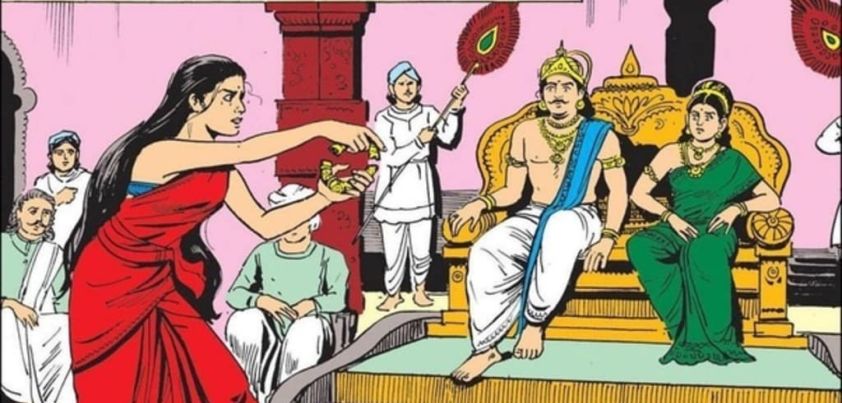 This story by R. K. Narayan, is based on the Tamil legend of Kannagi, a devoted wife who stands by her husband despite his love affair with a dancer. When he finally repents after squandering their fortune on entertainment and gifts for the other woman, they move to another city. They live happily there until Kannagi’s husband is framed for theft and summarily executed while trying to sell one of her gold anklets. Kannagi’s wrath is so great that she calls on the gods and has the city destroyed. Later, she learns that her fate was the result of karma. More…
This story by R. K. Narayan, is based on the Tamil legend of Kannagi, a devoted wife who stands by her husband despite his love affair with a dancer. When he finally repents after squandering their fortune on entertainment and gifts for the other woman, they move to another city. They live happily there until Kannagi’s husband is framed for theft and summarily executed while trying to sell one of her gold anklets. Kannagi’s wrath is so great that she calls on the gods and has the city destroyed. Later, she learns that her fate was the result of karma. More…
Momotarō
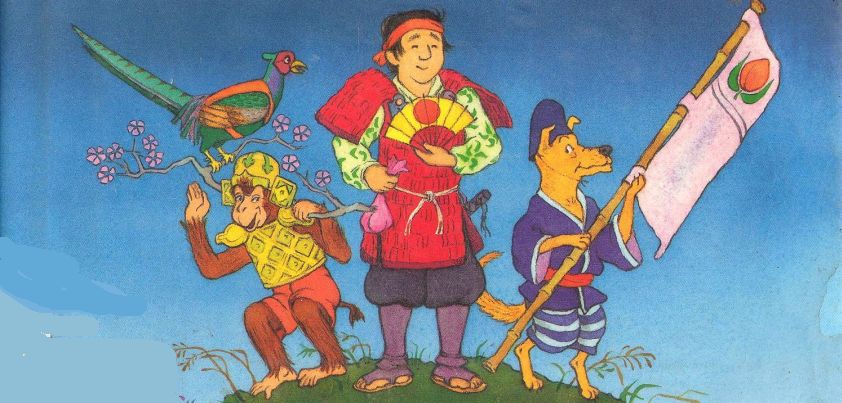 In this famous Japanese folktale, a childless couple’s prayers are answered when a giant peach splits open to reveal a baby boy. The boy grows up to be the strongest and wisest lad in the land and, at fifteen, decides to give his poor parents an easier life by traveling to an island off the Northeast coast of Japan, destroying a band of cannibalistic demons that are terrorizing the land, and bringing back their treasure. Along the way he gathers troupe of anthropomorphic animal friends who, in predictable folktale form, help him easily win the day. More…
In this famous Japanese folktale, a childless couple’s prayers are answered when a giant peach splits open to reveal a baby boy. The boy grows up to be the strongest and wisest lad in the land and, at fifteen, decides to give his poor parents an easier life by traveling to an island off the Northeast coast of Japan, destroying a band of cannibalistic demons that are terrorizing the land, and bringing back their treasure. Along the way he gathers troupe of anthropomorphic animal friends who, in predictable folktale form, help him easily win the day. More…
The Bunyip
 Folklore is full of stories of fierce mythical creatures. North America has Bigfoot or the Sasquatch, Nepal and Tibet have the Yeti, and Australia has the Yowie/Yahoo and water-dwelling Bunyip. Bunyip sightings have been reported since the early days of settlement, and today’s story is one of the first literary accounts of the creature. A foolish aboriginal hunter tries to kidnap a Bunyip cub, secure in the knowledge that he can out-run its clumsy mother on land. He learns too late that the mother has magic powers that will change his people forever. More…
Folklore is full of stories of fierce mythical creatures. North America has Bigfoot or the Sasquatch, Nepal and Tibet have the Yeti, and Australia has the Yowie/Yahoo and water-dwelling Bunyip. Bunyip sightings have been reported since the early days of settlement, and today’s story is one of the first literary accounts of the creature. A foolish aboriginal hunter tries to kidnap a Bunyip cub, secure in the knowledge that he can out-run its clumsy mother on land. He learns too late that the mother has magic powers that will change his people forever. More…
The Emperor’s New Clothes
 The main theme of this famous children’s story from Hans Christian Andersen is, of course, vanity. Other themes include deceit, gullibility, honesty (fear of speaking up) and pride. The Emperor who puts appearance before the well-being of his people, and his courtiers who sense that something is amiss but don’t have the courage to report it, carry two important messages. We shouldn’t judge people by the clothes they wear, what brand of phone they carry etc., and children should be encouraged to speak up if safe to do so when they see something that is wrong. More…
The main theme of this famous children’s story from Hans Christian Andersen is, of course, vanity. Other themes include deceit, gullibility, honesty (fear of speaking up) and pride. The Emperor who puts appearance before the well-being of his people, and his courtiers who sense that something is amiss but don’t have the courage to report it, carry two important messages. We shouldn’t judge people by the clothes they wear, what brand of phone they carry etc., and children should be encouraged to speak up if safe to do so when they see something that is wrong. More…
A Tale of the Tontlawald
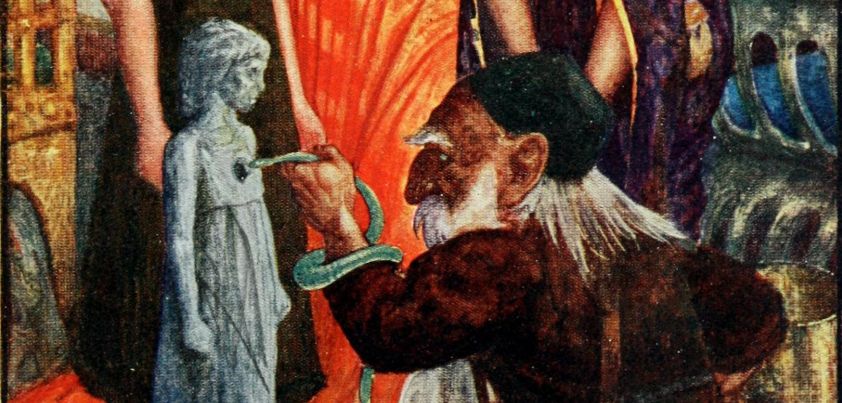 As is all too often the case in folk and fairy tales, the central plot here involves a young girl who is badly treated by a cruel stepmother, has a series of adventures, marries a handsome prince, and lives happily ever after. The big difference here is that the finds refuge and friendship in Tontlawald, a vast stretch of moorland on which no man ever dared set foot. To her surprise, she learns that it is a magical fairyland where people never age. When she outgrows the playmate who discovered her, she is told that she must leave. More…
As is all too often the case in folk and fairy tales, the central plot here involves a young girl who is badly treated by a cruel stepmother, has a series of adventures, marries a handsome prince, and lives happily ever after. The big difference here is that the finds refuge and friendship in Tontlawald, a vast stretch of moorland on which no man ever dared set foot. To her surprise, she learns that it is a magical fairyland where people never age. When she outgrows the playmate who discovered her, she is told that she must leave. More…
Agkon, the Greedy Son
 In this Philippine (Kalingga) folktale, a mother revives a rotting corpse to punish her only son for not sharing a meal. Not only is the punishment rather extreme, but when the poor lad is no more she regrets the decision… not because she loved the boy, but because she is lonely and has nobody else to help around the house. So, off to the river with some of his blood, a few magic words, and presto! He is back, having learned an important lesson about sharing. Unfortunately, there is no punishment for the mother’s cruelty and heartlessness! More…
In this Philippine (Kalingga) folktale, a mother revives a rotting corpse to punish her only son for not sharing a meal. Not only is the punishment rather extreme, but when the poor lad is no more she regrets the decision… not because she loved the boy, but because she is lonely and has nobody else to help around the house. So, off to the river with some of his blood, a few magic words, and presto! He is back, having learned an important lesson about sharing. Unfortunately, there is no punishment for the mother’s cruelty and heartlessness! More…
Waters of Gold
 This Chinese folktale retold by Laurence Yep is in two parts. First, readers encounter the kind-hearted Auntie Lily who has spent so much of her money helping others that she now lives in poverty. Her fortunes change for the better when she helps a filthy, foul-smelling beggar who everyone else ignores. Later, her greedy neighbour experiences a different result when, hoping for a similar reward, she helps the same man. The two parts show different sides of the “be kind to others” moral: kindness for kindness’s sake brings its own rewards; kindness in expectation of reward usually leads to disappointment. More…
This Chinese folktale retold by Laurence Yep is in two parts. First, readers encounter the kind-hearted Auntie Lily who has spent so much of her money helping others that she now lives in poverty. Her fortunes change for the better when she helps a filthy, foul-smelling beggar who everyone else ignores. Later, her greedy neighbour experiences a different result when, hoping for a similar reward, she helps the same man. The two parts show different sides of the “be kind to others” moral: kindness for kindness’s sake brings its own rewards; kindness in expectation of reward usually leads to disappointment. More…
What the Old Man Does is Always Right
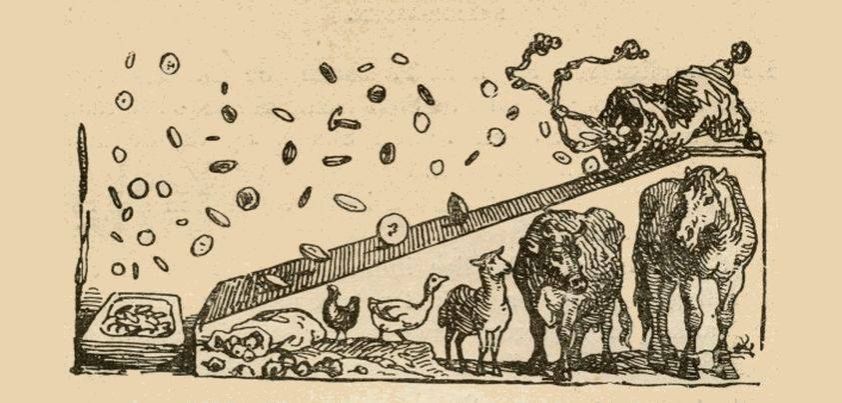 This story by Hans Christian Andersen is about an old man and his loving wife who never sees a problem with anything he does. The only thing they own of any value is a horse, which they decide to sell or trade for something more useful. The man sets off for town and, after several trades along the way, comes home with a bag of rotten apples. As always, his wife was delighted with the result. Andersen called this story one of his best ever tales… but was it really his work? More…
This story by Hans Christian Andersen is about an old man and his loving wife who never sees a problem with anything he does. The only thing they own of any value is a horse, which they decide to sell or trade for something more useful. The man sets off for town and, after several trades along the way, comes home with a bag of rotten apples. As always, his wife was delighted with the result. Andersen called this story one of his best ever tales… but was it really his work? More…
Federigo’s Falcon
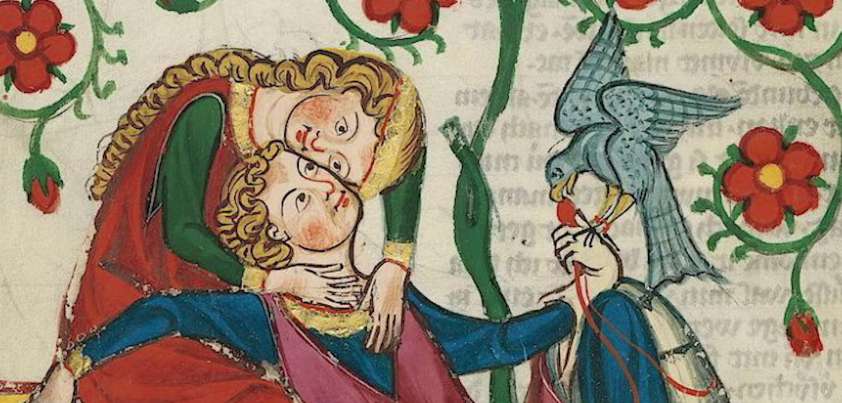 Officials issued public pleas and advised residents on measures that would minimise risk of contagion, such as social distancing and increased personal hygiene. Sound familiar? This comes from the introduction to The Decameron, a 1353 collection of tales told by a fictitious group hiding from the plague (smallpox). Although most of the stories were borrowed from early Eastern and European sources, Italian author Giovanni Boccaccio cleverly re-wrote (and in some cases reinvented) them into a fascinating account of life at the time. In this story, a poor noble mistakenly sacrifices his prized hunting bird to impress the woman he loves. More…
Officials issued public pleas and advised residents on measures that would minimise risk of contagion, such as social distancing and increased personal hygiene. Sound familiar? This comes from the introduction to The Decameron, a 1353 collection of tales told by a fictitious group hiding from the plague (smallpox). Although most of the stories were borrowed from early Eastern and European sources, Italian author Giovanni Boccaccio cleverly re-wrote (and in some cases reinvented) them into a fascinating account of life at the time. In this story, a poor noble mistakenly sacrifices his prized hunting bird to impress the woman he loves. More…
The Aged Mother
 This very short folktale has a very big message. First recorded by Matsuo Bashō in the late 15th century, its moral (respect for the knowledge and wisdom of the aged) is just as relevant today as it was then. Unfortunately, the governor’s reasoning doesn’t go far enough. His ruling suggests that the only reason society should care for the aged is that it has something to gain from them. This ignores any contribution that older people have already made. The farmer had the right idea by showing gratitude (and risking his life) for his mother’s life-long love and care. More…
This very short folktale has a very big message. First recorded by Matsuo Bashō in the late 15th century, its moral (respect for the knowledge and wisdom of the aged) is just as relevant today as it was then. Unfortunately, the governor’s reasoning doesn’t go far enough. His ruling suggests that the only reason society should care for the aged is that it has something to gain from them. This ignores any contribution that older people have already made. The farmer had the right idea by showing gratitude (and risking his life) for his mother’s life-long love and care. More…
Cap O’ Rushes
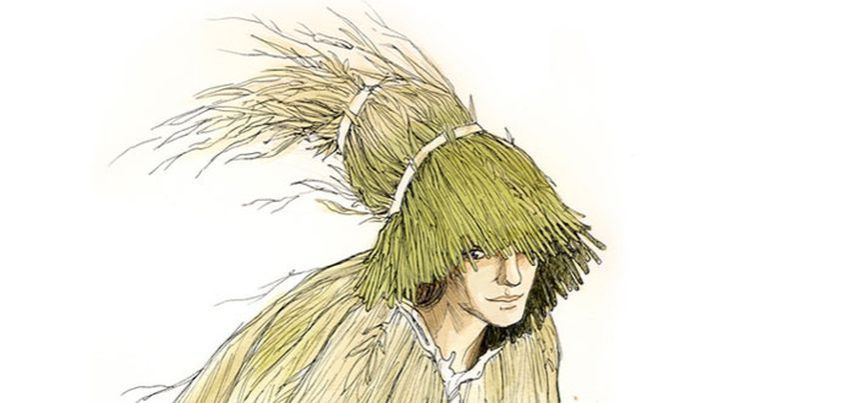 Some people liken the beginning of this folktale to Shakespeare’s King Lear. A rich man asks his daughters how much they love him. One answers in a way he does not understand. He mistakenly thinks she doesn’t love him and throws her out of the house. She makes a cloak out of rushes to hide her fine clothes and finds a job cooking and cleaning. That is, of course, until she meets her true love at a ball and turns her bad luck into a ‘happily-ever-after’ ending. Sadly, this sweet-sounding tale may have a more sinister underlying theme. More…
Some people liken the beginning of this folktale to Shakespeare’s King Lear. A rich man asks his daughters how much they love him. One answers in a way he does not understand. He mistakenly thinks she doesn’t love him and throws her out of the house. She makes a cloak out of rushes to hide her fine clothes and finds a job cooking and cleaning. That is, of course, until she meets her true love at a ball and turns her bad luck into a ‘happily-ever-after’ ending. Sadly, this sweet-sounding tale may have a more sinister underlying theme. More…
Sweet Porridge
 In this German folktale (also known as The Magic Porridge Pot), a kind old woman gives a magic pot to a poor girl looking for something to eat in a forest. When someone says special words, the pot cooks sweet porridge. The only problem for the girl, her mother and the village they live in is that you need to say special words to make the pot stop cooking. This is a popular teaching story for 3-5 year-olds, made more so because the poem that inspired it was also the source for a famous Disney film segment. More…
In this German folktale (also known as The Magic Porridge Pot), a kind old woman gives a magic pot to a poor girl looking for something to eat in a forest. When someone says special words, the pot cooks sweet porridge. The only problem for the girl, her mother and the village they live in is that you need to say special words to make the pot stop cooking. This is a popular teaching story for 3-5 year-olds, made more so because the poem that inspired it was also the source for a famous Disney film segment. More…
Kate Crackernuts
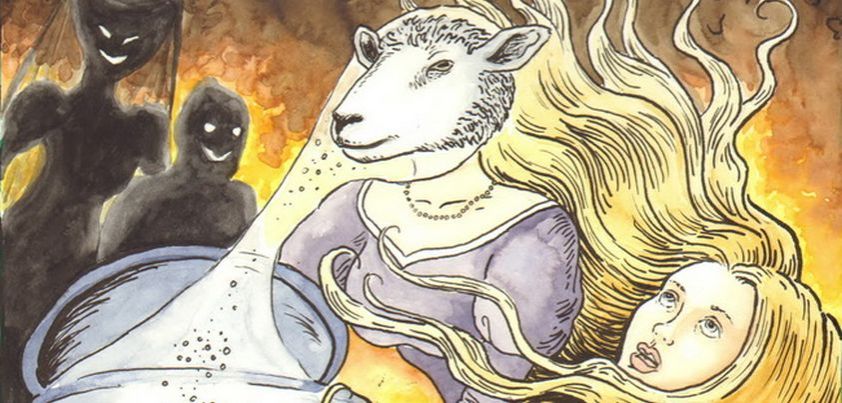 What’s this? A folktale where a wicked queen doesn’t come to a terrible end and stepsisters love each other! Where’s the fun in that? A queen is unhappy that her stepdaughter is more beautiful than her own daughter. So, with a little magic, she pops a sheep’s head onto the prettier one’s shoulders. The two girls run away together and of course marry handsome princes. However, I am a bit worried about a possible message from the story, which seems to suggest that it is OK to steal from babies as long as you do it for a good cause. More…
What’s this? A folktale where a wicked queen doesn’t come to a terrible end and stepsisters love each other! Where’s the fun in that? A queen is unhappy that her stepdaughter is more beautiful than her own daughter. So, with a little magic, she pops a sheep’s head onto the prettier one’s shoulders. The two girls run away together and of course marry handsome princes. However, I am a bit worried about a possible message from the story, which seems to suggest that it is OK to steal from babies as long as you do it for a good cause. More…
Diamond Cuts Diamond
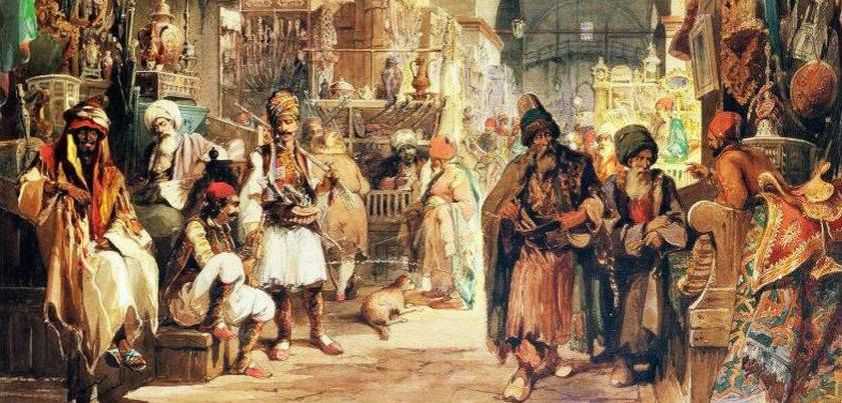 In this Indian folktale, a man travels to a distant land to seek his fortune. He succeeds and decides to convert his riches to jewels and return home. As he nears home, a ‘friendly’ merchant warns him that there are robbers on the road ahead. The traveler leaves his jewels in the care of the merchant. He then travels home to hire men to help him get the jewels through safely. On his return, the merchant tries to cheat him. To get the jewels back, the traveler needs help from someone who is even better at cheating than the merchant. More…
In this Indian folktale, a man travels to a distant land to seek his fortune. He succeeds and decides to convert his riches to jewels and return home. As he nears home, a ‘friendly’ merchant warns him that there are robbers on the road ahead. The traveler leaves his jewels in the care of the merchant. He then travels home to hire men to help him get the jewels through safely. On his return, the merchant tries to cheat him. To get the jewels back, the traveler needs help from someone who is even better at cheating than the merchant. More…
Fairy Ointment
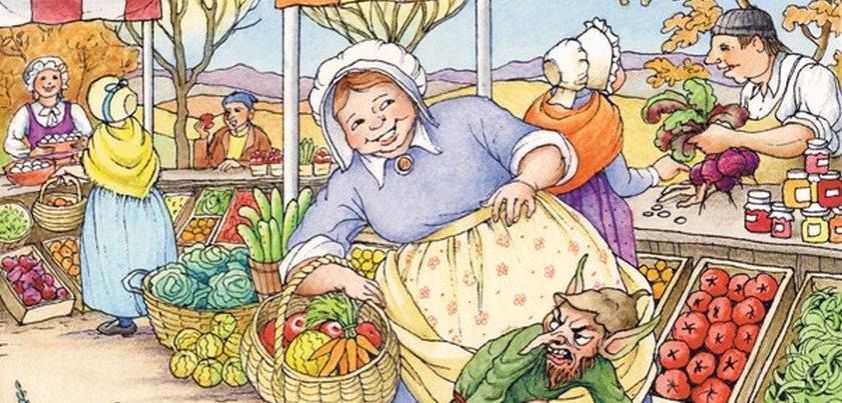 In this folktale, a strange looking little old man asks a nurse to come to his house to help his sick wife look after their baby boy. The man’s wife gives the nurse some ointment to put on the baby’s eyes. Being curious, the nurse puts some of it on one of her own eyes. The family seemed normal enough up to this point. However, the ointment helps her to learn their secret. The nurse pays a heavy price for her actions when the old man finds out what she has done. More…
In this folktale, a strange looking little old man asks a nurse to come to his house to help his sick wife look after their baby boy. The man’s wife gives the nurse some ointment to put on the baby’s eyes. Being curious, the nurse puts some of it on one of her own eyes. The family seemed normal enough up to this point. However, the ointment helps her to learn their secret. The nurse pays a heavy price for her actions when the old man finds out what she has done. More…
The Secret Room
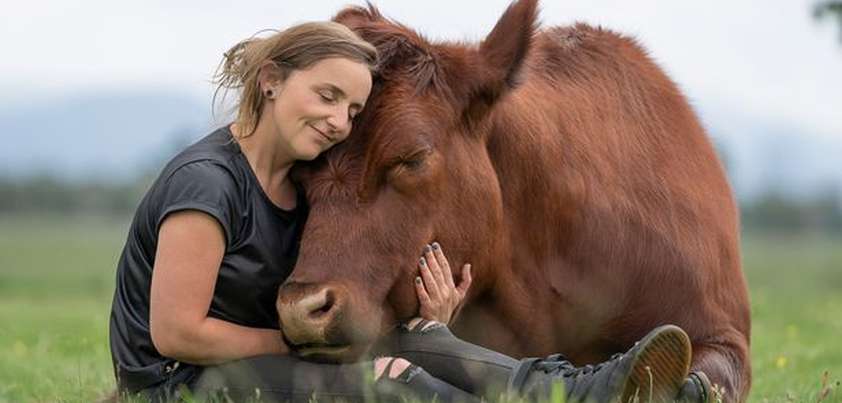 Although attributed to the folklore of Schoharie County New York, this folktale almost certainly has German origins. In common with Perrault’s famous Bluebeard, the plot involves a large house, a set of keys and a room that must not be entered. The main difference is that in this story the heroine falls in love with and marries a bull! Having killed and decapitated her older sisters, the beast was planning the same fate for her. The story teaches two life lessons: 1) don’t let curiosity get the better of you; and 2) black cats are not so evil after all. More…
Although attributed to the folklore of Schoharie County New York, this folktale almost certainly has German origins. In common with Perrault’s famous Bluebeard, the plot involves a large house, a set of keys and a room that must not be entered. The main difference is that in this story the heroine falls in love with and marries a bull! Having killed and decapitated her older sisters, the beast was planning the same fate for her. The story teaches two life lessons: 1) don’t let curiosity get the better of you; and 2) black cats are not so evil after all. More…
The Three Wonderful Beggars
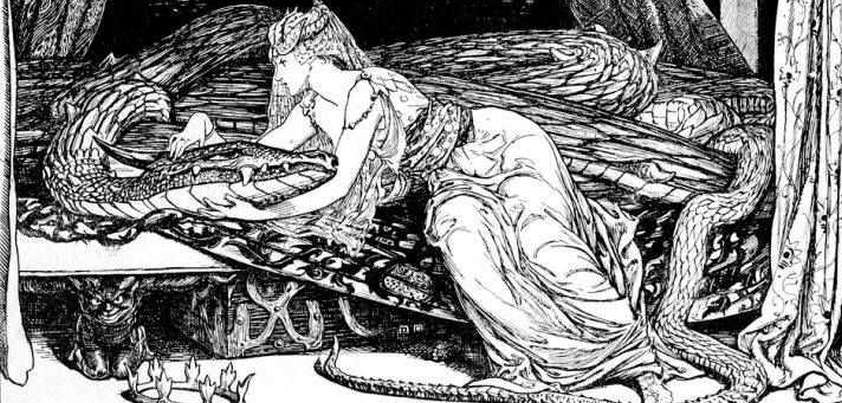 In this Serbian folktale, a young girl stops her rich but cruel father from setting his dogs on three old men who come begging to his door. The old men are not really beggars, but fairies. They foretell that a baby boy in a nearby village will one day own all the rich man’s money and land. The rich man learns this and tries several times to kill the boy. However, he boy survives and the fairies’ prophesy comes true. As a final punishment, the rich man must work forever in a job that is much worse than begging. More…
In this Serbian folktale, a young girl stops her rich but cruel father from setting his dogs on three old men who come begging to his door. The old men are not really beggars, but fairies. They foretell that a baby boy in a nearby village will one day own all the rich man’s money and land. The rich man learns this and tries several times to kill the boy. However, he boy survives and the fairies’ prophesy comes true. As a final punishment, the rich man must work forever in a job that is much worse than begging. More…
How Suan Became Rich
 In this Tagalog folktale from the Philippines, a rich man (Pedro) gives a friend (Suan) a post so that he can build himself a house. Pedro becomes unhappy when Suan’s new house is bigger than his. He asks Suan to return the post, which he can’t do or the house will fall down. Pedro takes Suan before the king to get the post back. On the way, Suan experiences further problems. He accidentally kills someone and breaks off a carabao (buffalo) tail. However, thanks to the wise king, Suan keeps the post and becomes the richest man in his village. More…
In this Tagalog folktale from the Philippines, a rich man (Pedro) gives a friend (Suan) a post so that he can build himself a house. Pedro becomes unhappy when Suan’s new house is bigger than his. He asks Suan to return the post, which he can’t do or the house will fall down. Pedro takes Suan before the king to get the post back. On the way, Suan experiences further problems. He accidentally kills someone and breaks off a carabao (buffalo) tail. However, thanks to the wise king, Suan keeps the post and becomes the richest man in his village. More…
The Golden Goose
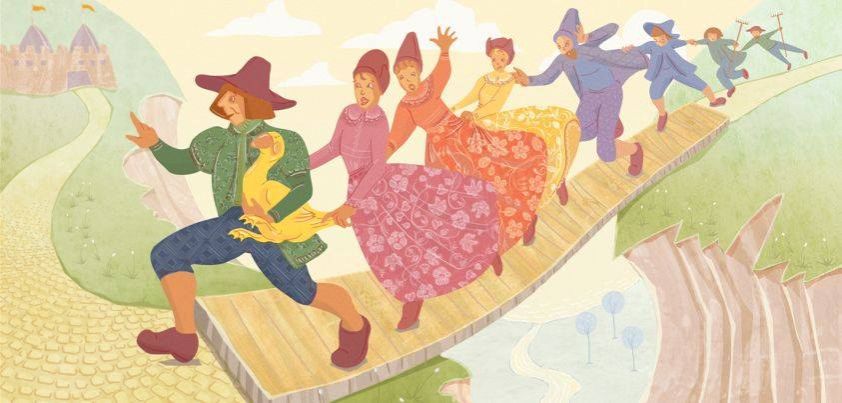 The Golden Goose is about a kind but not very clever young man who one day shares his food with a hungry old man. The old man tells him where to find a goose that has feathers of gold. The goose has a strange power. Those who touch it, and any who touch them, cannot remove their hands. A king, who has a daughter that has never laughed, has promised that she will marry the first man to make do so. The man and goose, with seven people running behind stuck fast to them, look silly enough to do this. More…
The Golden Goose is about a kind but not very clever young man who one day shares his food with a hungry old man. The old man tells him where to find a goose that has feathers of gold. The goose has a strange power. Those who touch it, and any who touch them, cannot remove their hands. A king, who has a daughter that has never laughed, has promised that she will marry the first man to make do so. The man and goose, with seven people running behind stuck fast to them, look silly enough to do this. More…
Tom Tit Tot / Rumpelstiltskin
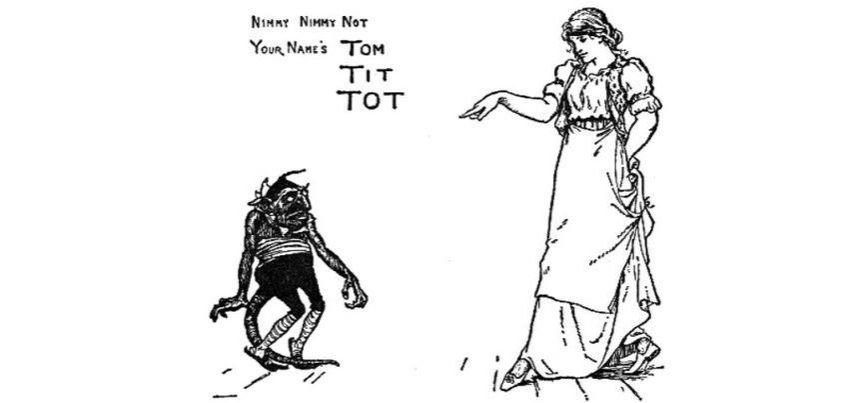 The protagonist in Tom Tit Tot is a lazy girl who doesn’t appear to be good at anything except eating. Her mother lies to the king by saying she is a whiz with the spinning wheel. For some reason this is just the kind of girl the king is looking to marry. The poor girl can’t even spin a top, so in order to avoid losing her head she accepts an offer of help from a small magical creature. As the creature helps the girl, she must try to guess its name. If she can’t, she shall become “its”. More…
The protagonist in Tom Tit Tot is a lazy girl who doesn’t appear to be good at anything except eating. Her mother lies to the king by saying she is a whiz with the spinning wheel. For some reason this is just the kind of girl the king is looking to marry. The poor girl can’t even spin a top, so in order to avoid losing her head she accepts an offer of help from a small magical creature. As the creature helps the girl, she must try to guess its name. If she can’t, she shall become “its”. More…
The Homecoming
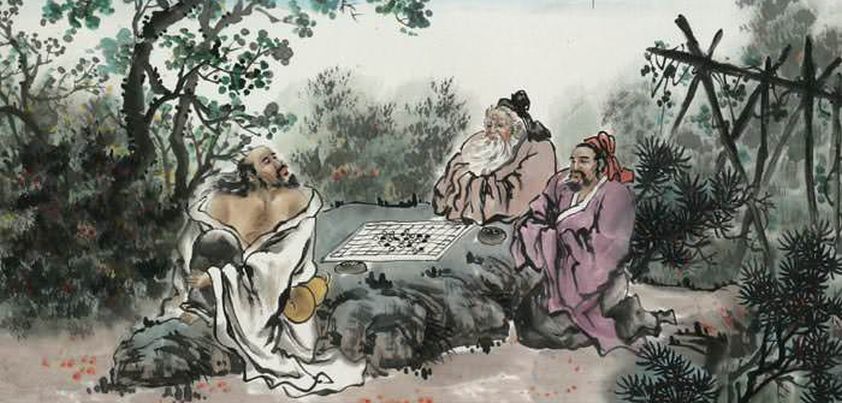 This Chinese folktale retold by Laurence Yep is about a poor woodcutter who is easily distracted. He takes a keen interest in everyone’s business but his own, and has an annoying habit of giving advice, whether asked for or not, pointing out how people he meets could do things better. One day, he comes across two strange men playing Xiangqi (Chinese chess) in a forest, and can’t resist stopping to offer suggestions about their best next moves. In a Rip Van Winkle-like conclusion, he finds many changes on returning home, having been being missing for thousands of years More…
This Chinese folktale retold by Laurence Yep is about a poor woodcutter who is easily distracted. He takes a keen interest in everyone’s business but his own, and has an annoying habit of giving advice, whether asked for or not, pointing out how people he meets could do things better. One day, he comes across two strange men playing Xiangqi (Chinese chess) in a forest, and can’t resist stopping to offer suggestions about their best next moves. In a Rip Van Winkle-like conclusion, he finds many changes on returning home, having been being missing for thousands of years More…
The Three Sillies
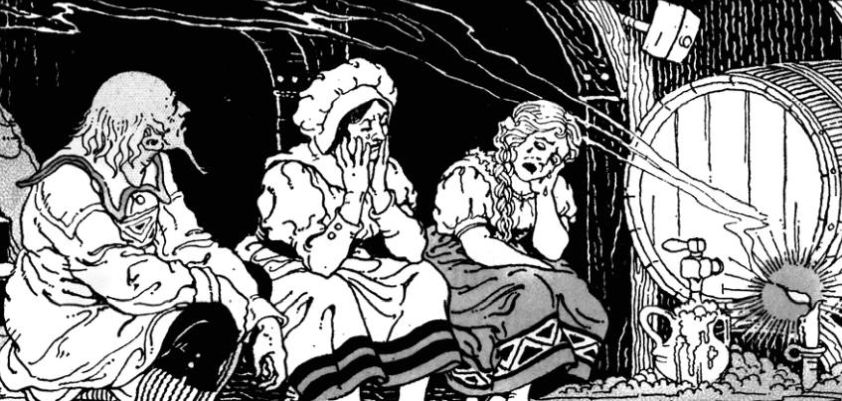 Not all folktales are designed to teach or explain. Some, like this one, were popular for their entertainment value. In this story, a rich young man finds that the woman he loves and her family are not very clever. He decides that he will only marry the girl if he can find three people sillier than they are. A woman trying to push her cow up a ladder, a man who can’t get his trousers on, and a whole village trying to rescue a shadow from a pond prove that there certainly are sillier people in the world. More…
Not all folktales are designed to teach or explain. Some, like this one, were popular for their entertainment value. In this story, a rich young man finds that the woman he loves and her family are not very clever. He decides that he will only marry the girl if he can find three people sillier than they are. A woman trying to push her cow up a ladder, a man who can’t get his trousers on, and a whole village trying to rescue a shadow from a pond prove that there certainly are sillier people in the world. More…
Cat and Mouse in Partnership
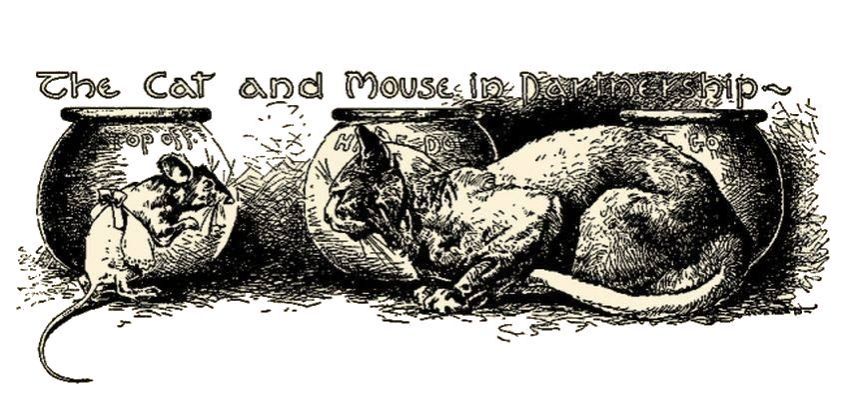 This folktale is about a greedy cat that cheats a trusting friend. A cat and mouse decide to live together. They discover a pot of ‘fat’ (probably dripping) and hide it in a safe place so they will have something to eat over winter. Unfortunately, the cat cannot stop thinking about the pot and empties it well before time. In most folktales, something bad would happen to the cat to teach it a lesson. Not so here! When the mouse complains, the cat does what cats normally do. The moral: You can’t change the natural ways of the world. More…
This folktale is about a greedy cat that cheats a trusting friend. A cat and mouse decide to live together. They discover a pot of ‘fat’ (probably dripping) and hide it in a safe place so they will have something to eat over winter. Unfortunately, the cat cannot stop thinking about the pot and empties it well before time. In most folktales, something bad would happen to the cat to teach it a lesson. Not so here! When the mouse complains, the cat does what cats normally do. The moral: You can’t change the natural ways of the world. More…
The Two Frogs
 This Japanese folktale teaches some important lessons. Two frogs from different cities set off on a journey, each wanting to visit the other’s city. They meet on a mountaintop halfway and accidentally look back at their own city, thinking it their destination. Deciding that the two cities look the same, they each return home. Possible morals: 1) If you really want to do something, learn all you can about it before you start; and 2) Don’t look for reasons to give up in the middle of something important. They are too easy to find and you may be sorry later. More…
This Japanese folktale teaches some important lessons. Two frogs from different cities set off on a journey, each wanting to visit the other’s city. They meet on a mountaintop halfway and accidentally look back at their own city, thinking it their destination. Deciding that the two cities look the same, they each return home. Possible morals: 1) If you really want to do something, learn all you can about it before you start; and 2) Don’t look for reasons to give up in the middle of something important. They are too easy to find and you may be sorry later. More…
The Jogi’s Punishment
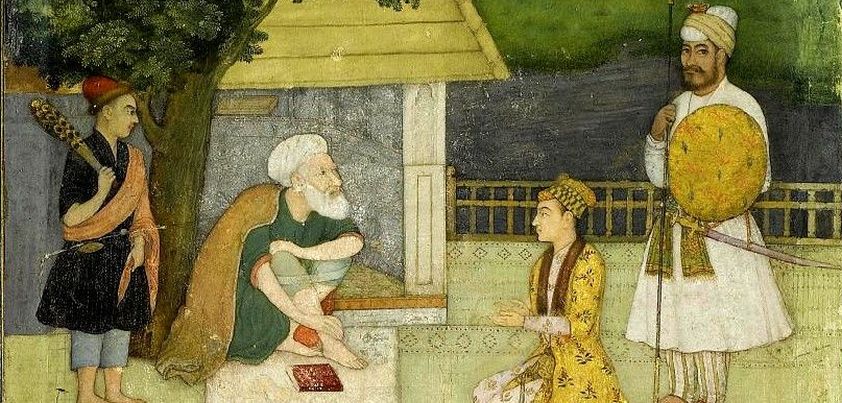 The moral of this Indian folktale appears to be that evil will always receive the punishment it deserves. We have a famed holy man who turns out to be not very holy after all, a selfish, gullible rajah who wants to keep the holy man’s talents and blessings all for himself, and an overly curious princess who disobeys her father’s order not to leave the palace grounds. We aren’t told much about the “gallant young prince of Dilaram” but he, too, must have done something wrong to be punished with the disobedient princess as a wife. More…
The moral of this Indian folktale appears to be that evil will always receive the punishment it deserves. We have a famed holy man who turns out to be not very holy after all, a selfish, gullible rajah who wants to keep the holy man’s talents and blessings all for himself, and an overly curious princess who disobeys her father’s order not to leave the palace grounds. We aren’t told much about the “gallant young prince of Dilaram” but he, too, must have done something wrong to be punished with the disobedient princess as a wife. More…
Mr Miacca
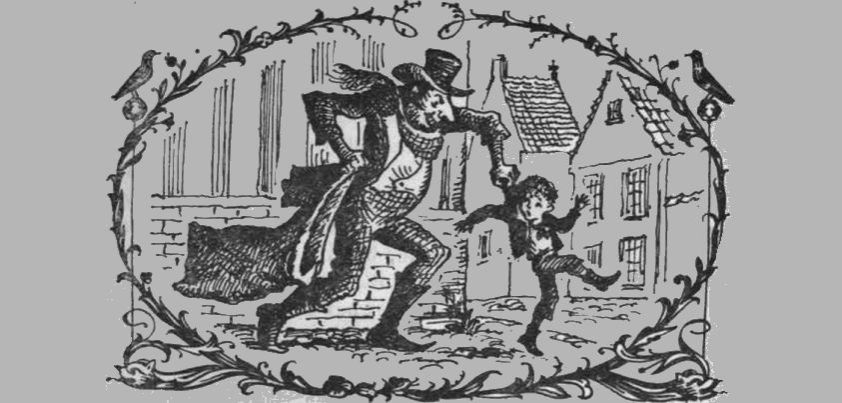 Mr. Miacca is an English folktale of the ‘bogeyman’ type, where adults tell stories of imaginary beings to frighten young children into being good. In the story, a boy does something wrong and finds himself about to be cooked for Mr. Miacca’s dinner. He gets away by tricking Mrs. Miacca. The forgetful boy makes the same mistake, and again finds himself on Mr. Miacca’s dinner menu. This time Mr. Miacca watches over the boy himself, and decides to cut off the lad’s leg (which he throws in the cooking pot) to make sure he doesn’t run away. More…
Mr. Miacca is an English folktale of the ‘bogeyman’ type, where adults tell stories of imaginary beings to frighten young children into being good. In the story, a boy does something wrong and finds himself about to be cooked for Mr. Miacca’s dinner. He gets away by tricking Mrs. Miacca. The forgetful boy makes the same mistake, and again finds himself on Mr. Miacca’s dinner menu. This time Mr. Miacca watches over the boy himself, and decides to cut off the lad’s leg (which he throws in the cooking pot) to make sure he doesn’t run away. More…
A Fish Story
 Although this story was described as an “Australian” folktale when published in 1910, Australia is too young a nation to have folktales of its own. This is an adaption of an Australian aboriginal myth. Like those of many ancient cultures, it tries to explain the meaning of every-day things: in this case, how fish got into rivers and why rivers always feel warmer if you swim in them on a cold day. According to the story, fish used to live and hunt on the land and only came to live underwater because of an accident lighting a fire. More…
Although this story was described as an “Australian” folktale when published in 1910, Australia is too young a nation to have folktales of its own. This is an adaption of an Australian aboriginal myth. Like those of many ancient cultures, it tries to explain the meaning of every-day things: in this case, how fish got into rivers and why rivers always feel warmer if you swim in them on a cold day. According to the story, fish used to live and hunt on the land and only came to live underwater because of an accident lighting a fire. More…
Brother and Sister
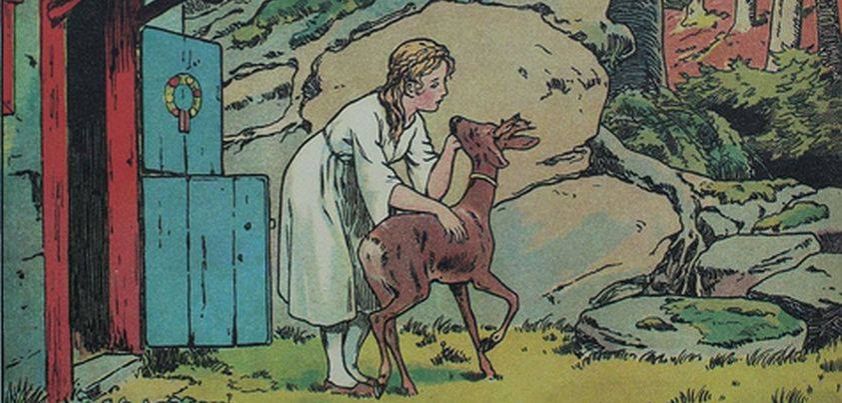 This is a well-known European folktale. A brother and sister run away from home after years of being badly treated by (you guessed it!) their wicked stepmother. The stepmother also happens to be a witch, and the children have some unlikely adventures. The brother is turned into a deer that loves nothing better than to be hunted. The sister becomes a Queen, has a baby, and is murdered by (you guessed it!) the wicked stepmother. Fortunately, the sister’s ghost comes back to life, the brother is made normal again, and they all (except the wicked stepmother) live happily ever after. More…
This is a well-known European folktale. A brother and sister run away from home after years of being badly treated by (you guessed it!) their wicked stepmother. The stepmother also happens to be a witch, and the children have some unlikely adventures. The brother is turned into a deer that loves nothing better than to be hunted. The sister becomes a Queen, has a baby, and is murdered by (you guessed it!) the wicked stepmother. Fortunately, the sister’s ghost comes back to life, the brother is made normal again, and they all (except the wicked stepmother) live happily ever after. More…
Donkey Skin
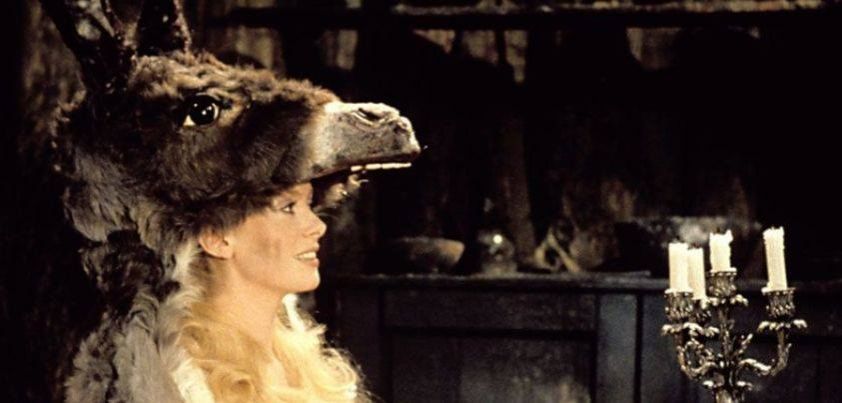 The lessons taught by many folktales are just as important today as they were hundreds of years ago. Donkey Skin deals with sexual abuse in the form of incest between father and daughter. A powerful king wants to marry his daughter, as this is the only way he can keep a promise he made to his dying wife. Fortunately, the brave girl has other ideas. I find it interesting that the story makes it clear that the king’s actions are wrong, but seems to have no problem with a handsome prince who spies on women through key holes. More…
The lessons taught by many folktales are just as important today as they were hundreds of years ago. Donkey Skin deals with sexual abuse in the form of incest between father and daughter. A powerful king wants to marry his daughter, as this is the only way he can keep a promise he made to his dying wife. Fortunately, the brave girl has other ideas. I find it interesting that the story makes it clear that the king’s actions are wrong, but seems to have no problem with a handsome prince who spies on women through key holes. More…
The Twelve Months
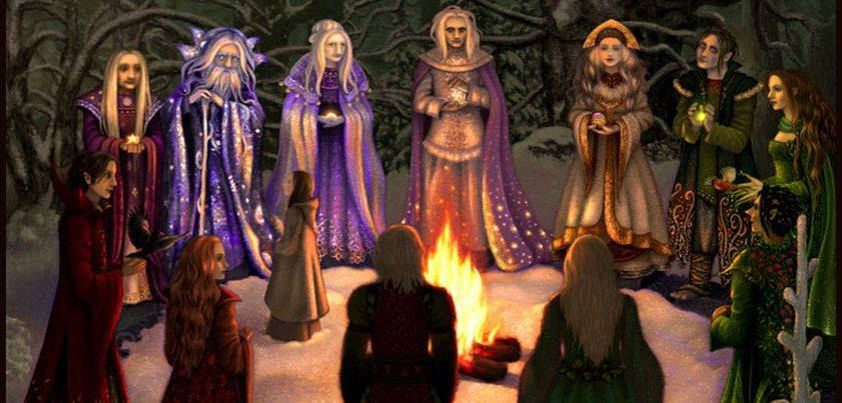 Although this folktale has been called the “Slavic Cinderella”, for me it doesn’t quite get there. We have a young girl persecuted by family and a magical element (the gods of the twelve months of the year) that helps her, but here the comparison ends. There is no ball or special event, no beautiful clothes, and no handsome prince. She falls in love with a kind man and the two spend a blissful life of drudgery taking care of her family farm. As nice as it seems, this is not what most people would call a ‘fairytale’ ending! More…
Although this folktale has been called the “Slavic Cinderella”, for me it doesn’t quite get there. We have a young girl persecuted by family and a magical element (the gods of the twelve months of the year) that helps her, but here the comparison ends. There is no ball or special event, no beautiful clothes, and no handsome prince. She falls in love with a kind man and the two spend a blissful life of drudgery taking care of her family farm. As nice as it seems, this is not what most people would call a ‘fairytale’ ending! More…
The Heart of a Monkey
 In this Swahili folktale, a monkey accepts the offer of a ride on a shark’s back to see the wonders under the sea. Once at sea, the monkey learns that the real reason for the trip is that the shark king needs a monkey’s heart to cure an illness. The monkey tricks the shark into returning. He then explains the trick by telling a story about a donkey, a hare, and a lion. One of the animals kills another. The third animal cooks it, but tells the killer there is no heart. Can you match the animals to the outcome? More…
In this Swahili folktale, a monkey accepts the offer of a ride on a shark’s back to see the wonders under the sea. Once at sea, the monkey learns that the real reason for the trip is that the shark king needs a monkey’s heart to cure an illness. The monkey tricks the shark into returning. He then explains the trick by telling a story about a donkey, a hare, and a lion. One of the animals kills another. The third animal cooks it, but tells the killer there is no heart. Can you match the animals to the outcome? More…
The Shifty Lad
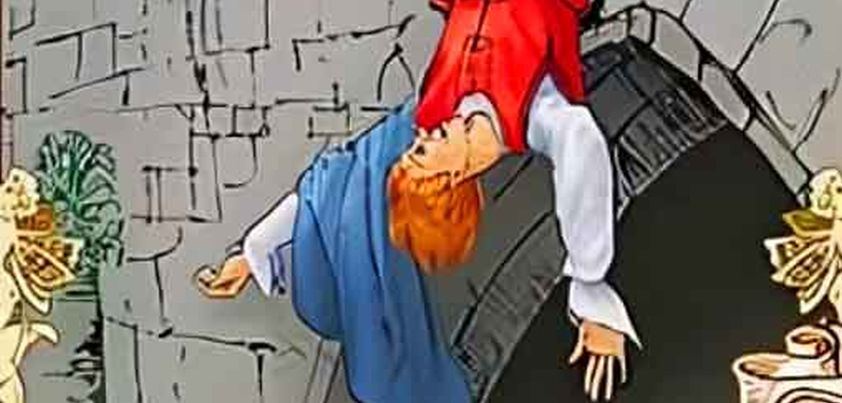 This Irish folktale is about a boy who likes to play tricks on people and wants nothing more than to grow up to be a thief. His mother warns him that if he does become a thief he will be caught one day and hang from the Bridge of Dublin. The boy does some rather terrible things on the way to becoming the most famous thief in the country. Luckily, there is still justice in some folktales and the Shifty Lad is soon lying dead under the Bridge of Dublin… but not for the reason his mother expected. More…
This Irish folktale is about a boy who likes to play tricks on people and wants nothing more than to grow up to be a thief. His mother warns him that if he does become a thief he will be caught one day and hang from the Bridge of Dublin. The boy does some rather terrible things on the way to becoming the most famous thief in the country. Luckily, there is still justice in some folktales and the Shifty Lad is soon lying dead under the Bridge of Dublin… but not for the reason his mother expected. More…
The Master Cat; or, Puss in Boots
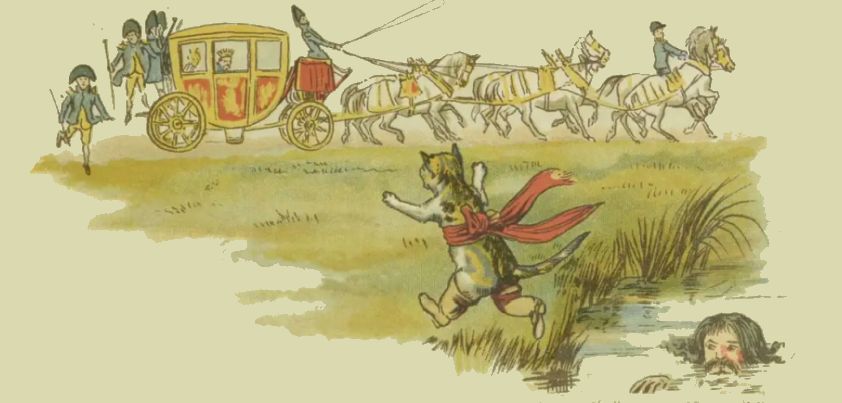 Puss in Boots is sometimes criticized for the mixed message it sends to children. Derived from a 14th Century Italian folktale, a clever cat helps its slow-witted master win the heart of a princess through trickery, lies, threats and theft. To condemn the story because of this seems a little unfair, since folklore is full of likeable tricksters whose crimes are far worse than the cat’s. These characters often play an important role, challenging traditional beliefs through satire. Here, the cat’s actions show up both the greed and gullibility of the king and the shallowness of his daughter. More…
Puss in Boots is sometimes criticized for the mixed message it sends to children. Derived from a 14th Century Italian folktale, a clever cat helps its slow-witted master win the heart of a princess through trickery, lies, threats and theft. To condemn the story because of this seems a little unfair, since folklore is full of likeable tricksters whose crimes are far worse than the cat’s. These characters often play an important role, challenging traditional beliefs through satire. Here, the cat’s actions show up both the greed and gullibility of the king and the shallowness of his daughter. More…
The Town Musicians of Bremen
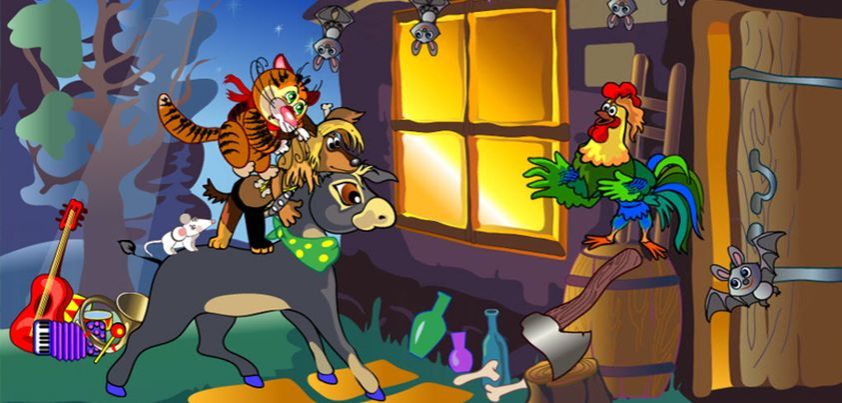 The Town Musicians of Bremen is a story about four animals that have worked hard all their lives. They are now too old to work and face either being badly treated or killed by their owners. One by one they leave their homes and set out together to become musicians in the town of Bremen. However, they never reach Bremen. During the journey, the animals come upon a house owned by a band of robbers. By working together, they are able to frighten the robbers away and live happily in the house for the rest of their days. More…
The Town Musicians of Bremen is a story about four animals that have worked hard all their lives. They are now too old to work and face either being badly treated or killed by their owners. One by one they leave their homes and set out together to become musicians in the town of Bremen. However, they never reach Bremen. During the journey, the animals come upon a house owned by a band of robbers. By working together, they are able to frighten the robbers away and live happily in the house for the rest of their days. More…
The Golden Nugget
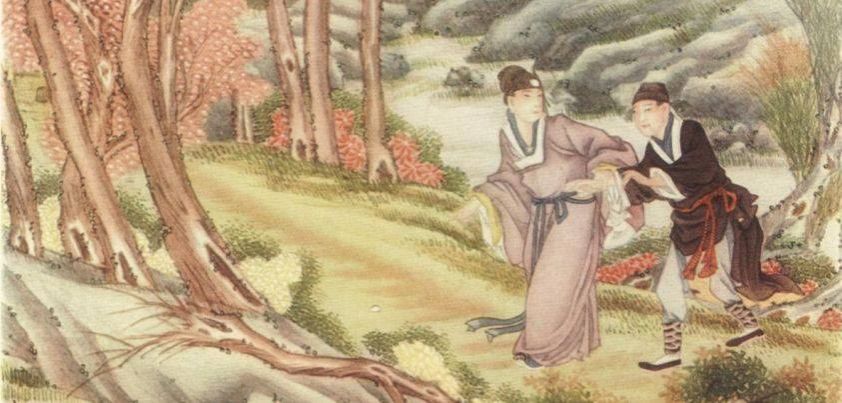 This Chinese folktale tells of two friends who would do anything for each other. One day they decide to go for a walk in a forest. During the walk, the friends see a gold nugget on the path. Unable to decide who should have it, they leave it where it is so as not to cause trouble between them. They later tell a greedy farmer about the nugget. He goes to get it, and becomes angry when he finds something unpleasant in its place. The two friends go back to look, and are well rewarded for their trouble. More…
This Chinese folktale tells of two friends who would do anything for each other. One day they decide to go for a walk in a forest. During the walk, the friends see a gold nugget on the path. Unable to decide who should have it, they leave it where it is so as not to cause trouble between them. They later tell a greedy farmer about the nugget. He goes to get it, and becomes angry when he finds something unpleasant in its place. The two friends go back to look, and are well rewarded for their trouble. More…
Hudden and Dudden and Donald O’Neary
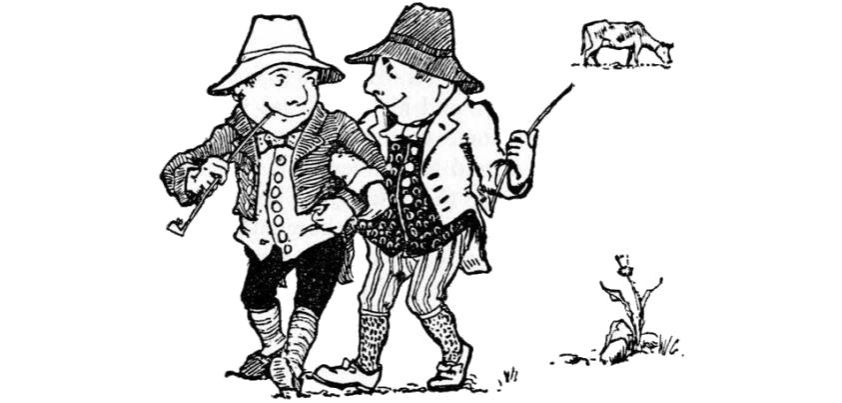 No one can make fun of themselves like the Irish. This quite funny folktale is about two well-off but foolish farmers named Hudden and Dudden. They will do anything to get their hands on a small piece of land between their two farms. This land belongs to a poor but clever man named Donald O’Neary. The story begins simply enough with Hudden and Dudden deciding to poison Donald’s faithful cow. Things escalate from there with Donald becoming rich and three people dying. By the end of the story, justice appears to have been served. But has it really? More…
No one can make fun of themselves like the Irish. This quite funny folktale is about two well-off but foolish farmers named Hudden and Dudden. They will do anything to get their hands on a small piece of land between their two farms. This land belongs to a poor but clever man named Donald O’Neary. The story begins simply enough with Hudden and Dudden deciding to poison Donald’s faithful cow. Things escalate from there with Donald becoming rich and three people dying. By the end of the story, justice appears to have been served. But has it really? More…
Bluebeard
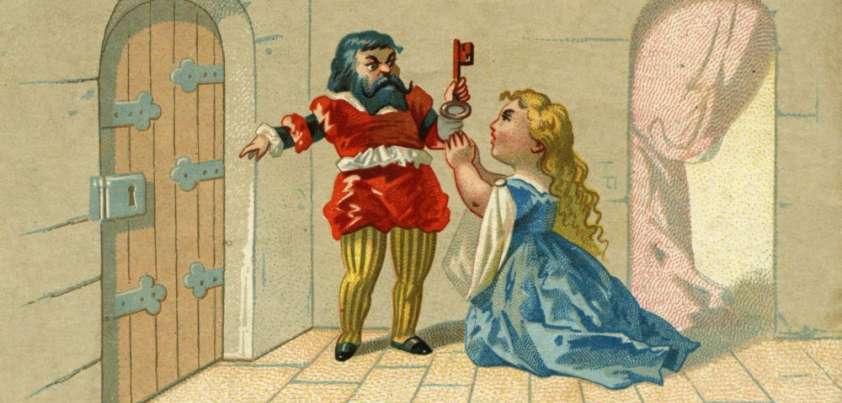 As in real life, many folktales have protagonists who attain riches and/or happiness by questionable means. Bluebeard, Charles Perrault’s serial killing nobleman, obviously deserves his fate. However, it is also hard to see how his last wife, who first rejected him based on his looks, seemingly only married him for his riches, and then betrayed his generosity and trust by entering a forbidden room, deserves a “happily ever after” future. Themes include judging by appearances, greed, vanity, betrayal of trust and justice. One question remains: if the beard made women and girls run away, why didn’t Bluebeard shave it off? More…
As in real life, many folktales have protagonists who attain riches and/or happiness by questionable means. Bluebeard, Charles Perrault’s serial killing nobleman, obviously deserves his fate. However, it is also hard to see how his last wife, who first rejected him based on his looks, seemingly only married him for his riches, and then betrayed his generosity and trust by entering a forbidden room, deserves a “happily ever after” future. Themes include judging by appearances, greed, vanity, betrayal of trust and justice. One question remains: if the beard made women and girls run away, why didn’t Bluebeard shave it off? More…
Diamond Cuts Diamond
 In this Thai folktale, a poor man has only plain rice to eat during a trip to visit a sick relative. Along the way, he smells some delicious curry being cooked for a rich man’s lunch. He stops nearby to eat his own lunch, and enjoys the plain rice more than ever because he imagines eating it with the curry. The rich man finds out about this and tries to make him pay for the smell of his curry. Thanks to a village chief who is cleverer than the rich man, things don’t go as he had planned. More…
In this Thai folktale, a poor man has only plain rice to eat during a trip to visit a sick relative. Along the way, he smells some delicious curry being cooked for a rich man’s lunch. He stops nearby to eat his own lunch, and enjoys the plain rice more than ever because he imagines eating it with the curry. The rich man finds out about this and tries to make him pay for the smell of his curry. Thanks to a village chief who is cleverer than the rich man, things don’t go as he had planned. More…
The Fish and the Ring
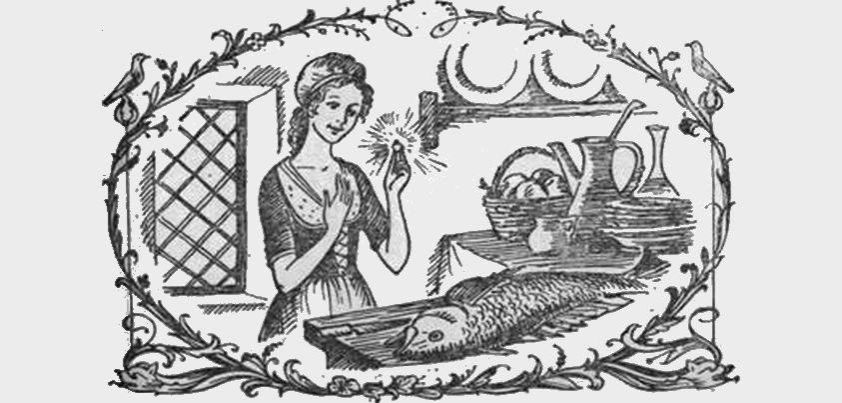 In this Scottish folktale, a rich and powerful man looks into the future and learns that the fate of his son is to marry a girl from a very poor family. He wants a high society wife for his son and does everything that he can to stop the marriage. He unsuccessfully tries to kill the poor girl twice, and is about to throw her over a cliff when she agrees to go away forever. A hungry fish brings them together again and teaches him that, no matter how much you try, you can’t change what is meant to be. More…
In this Scottish folktale, a rich and powerful man looks into the future and learns that the fate of his son is to marry a girl from a very poor family. He wants a high society wife for his son and does everything that he can to stop the marriage. He unsuccessfully tries to kill the poor girl twice, and is about to throw her over a cliff when she agrees to go away forever. A hungry fish brings them together again and teaches him that, no matter how much you try, you can’t change what is meant to be. More…
Wise Folks
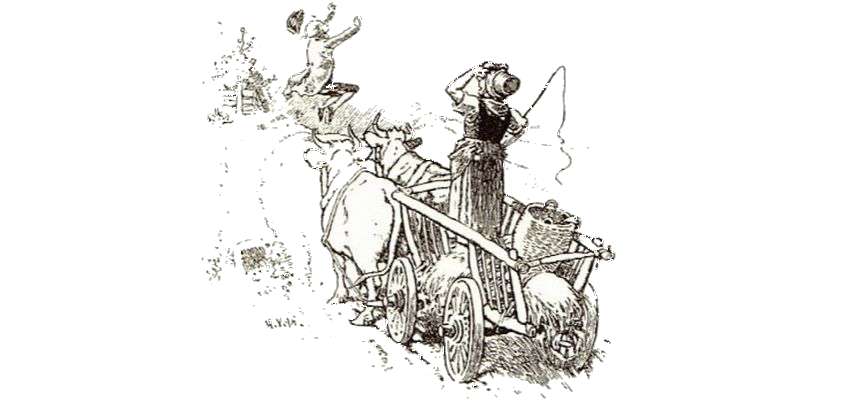 In this folktale (aka The Clever People), a cruel farmer is angry with his wife because she was cheated out of two cows. He promises not beat her for it if can find someone more foolish. He soon finds one: a widow who is worried about how well her dead husband is doing in Heaven. The farmer makes up for losing his cows by cheating the widow out of a bag of money and stealing a horse from her son. At the end of the story, he seems to think that it is OK to cheat foolish people. More…
In this folktale (aka The Clever People), a cruel farmer is angry with his wife because she was cheated out of two cows. He promises not beat her for it if can find someone more foolish. He soon finds one: a widow who is worried about how well her dead husband is doing in Heaven. The farmer makes up for losing his cows by cheating the widow out of a bag of money and stealing a horse from her son. At the end of the story, he seems to think that it is OK to cheat foolish people. More…
Toads and Diamonds (The Fairies)
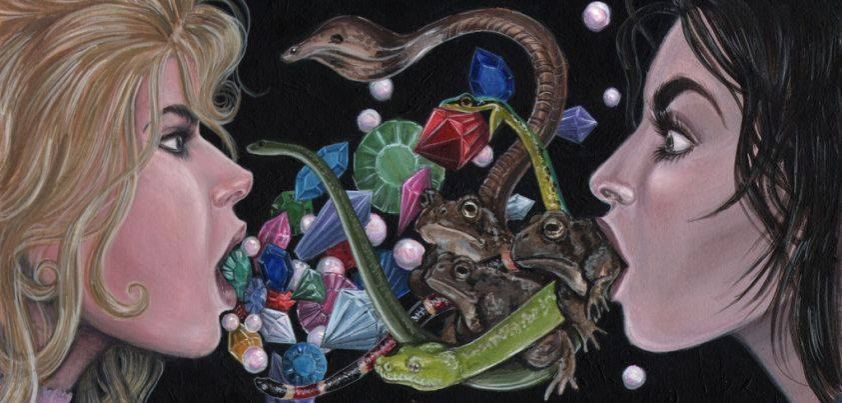 This story from Charles Perrault is about a bad-tempered, greedy widow and her two daughters. One girl is selfish, rude and ugly but loved by her mother. The other girl is kind, polite and beautiful but treated badly. With the help of a fairy (who else?), the kind daughter marries a prince and the selfish daughter dies alone. The story leaves readers wondering about the fairy’s gift. Life would be miserable (and maybe impossible) if something fell from your mouth every time you opened it? Also, did the prince really marry her out of love, or was it for diamonds? More…
This story from Charles Perrault is about a bad-tempered, greedy widow and her two daughters. One girl is selfish, rude and ugly but loved by her mother. The other girl is kind, polite and beautiful but treated badly. With the help of a fairy (who else?), the kind daughter marries a prince and the selfish daughter dies alone. The story leaves readers wondering about the fairy’s gift. Life would be miserable (and maybe impossible) if something fell from your mouth every time you opened it? Also, did the prince really marry her out of love, or was it for diamonds? More…
The Stonecutter
 This folktale from Japan is about a hardworking man who leads a poor but happy life until the day a mountain spirit decides to grant him several wishes. Predictably, his initial wish is for riches. When this does not satisfy, he craves power. He starts with power over man (as a prince), and moves on to power over nature (as the sun, a cloud, and a great rock on a mountainside). He is never satisfied until finally realizing that a humble stonecutter has as much power as anyone or anything on Earth. More…
This folktale from Japan is about a hardworking man who leads a poor but happy life until the day a mountain spirit decides to grant him several wishes. Predictably, his initial wish is for riches. When this does not satisfy, he craves power. He starts with power over man (as a prince), and moves on to power over nature (as the sun, a cloud, and a great rock on a mountainside). He is never satisfied until finally realizing that a humble stonecutter has as much power as anyone or anything on Earth. More…
Molly Whuppie
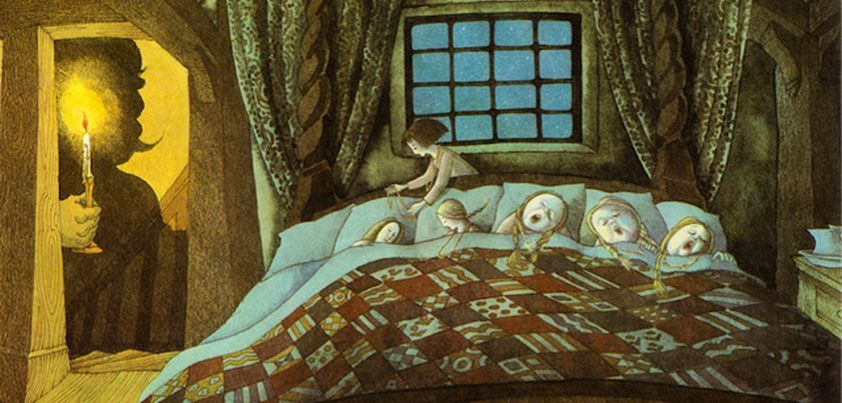 This Scottish folktale is one of those rare stories where the character who successfully defeats a giant is a girl. As often happens in folktales, Molly achieves this through gruesome actions. First, she tricks the giant into killing his three innocent daughters. Later, she tricks him into severely beating has kind wife, who had helped when Molly and her sisters needed food. As a reward, the girls marry into the family of a cowardly king who is happy to send Molly into danger three more times to satisfy his greed. There don’t seem to be any true heroes here. More…
This Scottish folktale is one of those rare stories where the character who successfully defeats a giant is a girl. As often happens in folktales, Molly achieves this through gruesome actions. First, she tricks the giant into killing his three innocent daughters. Later, she tricks him into severely beating has kind wife, who had helped when Molly and her sisters needed food. As a reward, the girls marry into the family of a cowardly king who is happy to send Molly into danger three more times to satisfy his greed. There don’t seem to be any true heroes here. More…
The False Prince and True
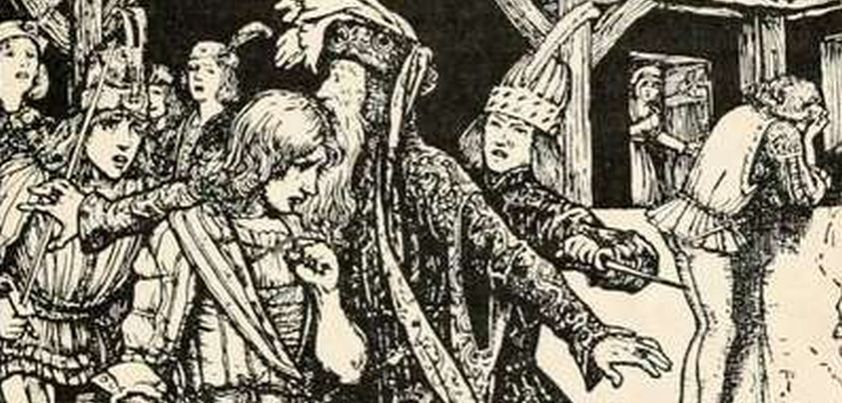 This Portuguese folktale begins with a king learning about an argument between his son and a young nobleman on a tennis court. The prince spoke rudely to the noble, who lost his temper and hit him. Although the king is angrier with his son for not fighting back than the noble, hitting the prince is punishable by death. The only way the noble can save himself is to marry a very ugly, very old woman. As is often the case in folktales, there is a lot of magic around and some surprises are on the way for all involved. More…
This Portuguese folktale begins with a king learning about an argument between his son and a young nobleman on a tennis court. The prince spoke rudely to the noble, who lost his temper and hit him. Although the king is angrier with his son for not fighting back than the noble, hitting the prince is punishable by death. The only way the noble can save himself is to marry a very ugly, very old woman. As is often the case in folktales, there is a lot of magic around and some surprises are on the way for all involved. More…
Sleeping Beauty
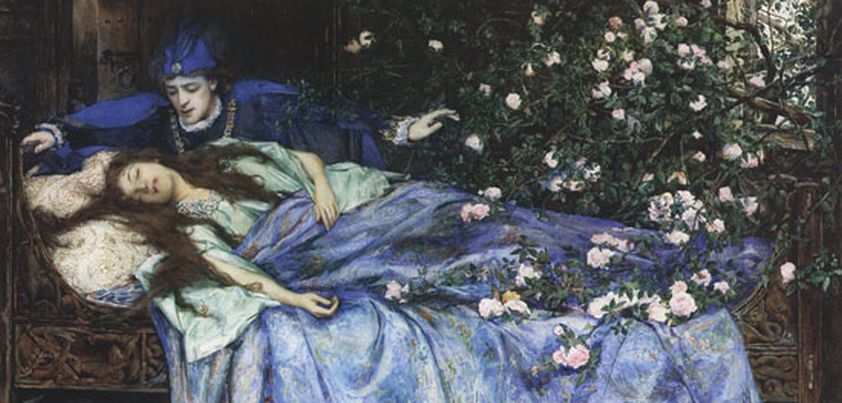 Today we have a reverse chronology of the folktales behind the classic children’s story, Sleeping Beauty. The famous kiss that woke the princess comes from the Brothers Grimm’s Briar-Rose (1812). Charles Perrault’s Sleeping Beauty in the Wood (1697) has no kiss but lots of talk, a hasty wedding followed by a night of “very little sleep”, and an added section where the prince’s mother (an Ogress) decides to make a meal of their children. Perault’s inspiration was the Giambattista Basile’s Sun, Moon and Talia (1634). Here, the king “gathers the first fruits of love” (rapes) the poor unconscious girl. More…
Today we have a reverse chronology of the folktales behind the classic children’s story, Sleeping Beauty. The famous kiss that woke the princess comes from the Brothers Grimm’s Briar-Rose (1812). Charles Perrault’s Sleeping Beauty in the Wood (1697) has no kiss but lots of talk, a hasty wedding followed by a night of “very little sleep”, and an added section where the prince’s mother (an Ogress) decides to make a meal of their children. Perault’s inspiration was the Giambattista Basile’s Sun, Moon and Talia (1634). Here, the king “gathers the first fruits of love” (rapes) the poor unconscious girl. More…
We Are All One
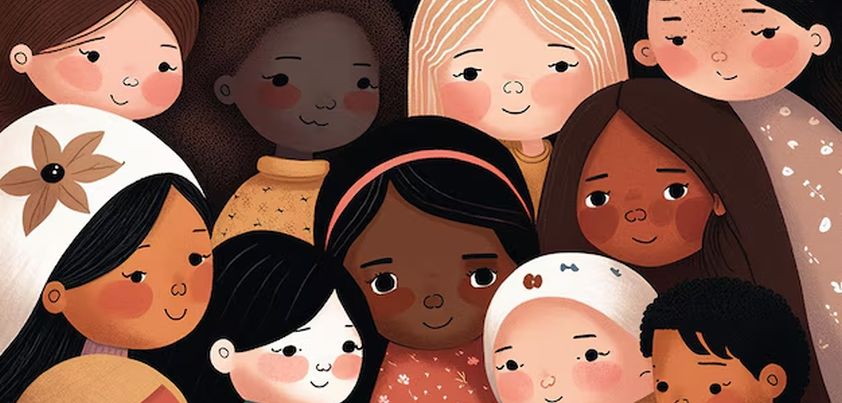 In this Chinese folktale retold by Laurence Yep, a rich merchant offers a large reward to anyone who can cure his painful eye disease. A poor candy peddler walks deep into a forest in search of a magical herb his mother had told him about. With help from a magical centipede and thousands of ants he becomes “One” with, he returns home with something better, earns the reward and lives happily ever after. The titular theme, that we are all one, conveyed an important social message to early Chinese immigrants in America. More…
In this Chinese folktale retold by Laurence Yep, a rich merchant offers a large reward to anyone who can cure his painful eye disease. A poor candy peddler walks deep into a forest in search of a magical herb his mother had told him about. With help from a magical centipede and thousands of ants he becomes “One” with, he returns home with something better, earns the reward and lives happily ever after. The titular theme, that we are all one, conveyed an important social message to early Chinese immigrants in America. More…
The Ass, the Table, and the Stick
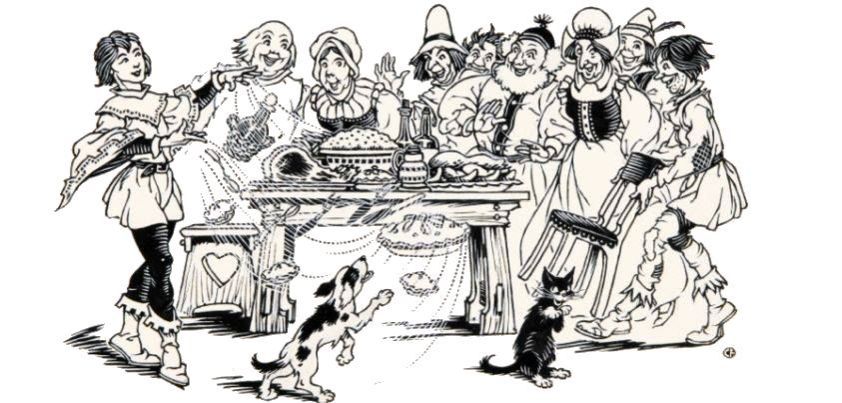 In this English folktale, a young man works for a year and earns a magic donkey. An innkeeper tricks him out of it, so he works for another year and earns a magic table. The same innkeeper tricks him out of this. For his next job, the boy earns a magic stick. This helps the young man get his donkey and table back, as well as to marry his true love. Unfortunately, in winning the girl the young man shows a side of his personality that will make readers wonder if he really deserved all the magical help! More…
In this English folktale, a young man works for a year and earns a magic donkey. An innkeeper tricks him out of it, so he works for another year and earns a magic table. The same innkeeper tricks him out of this. For his next job, the boy earns a magic stick. This helps the young man get his donkey and table back, as well as to marry his true love. Unfortunately, in winning the girl the young man shows a side of his personality that will make readers wonder if he really deserved all the magical help! More…
Tam and Cam
 As indicated in our comments on the famous children’s story Cinderella, there are hundreds of folktales around the world that have the similar central plots. This Vietnamese version is longer and continues after the protagonist becomes Queen. The story from here on could only happen in a folktale from a country where people believe that after we die we can be born again in non-human form. The poor girl is killed twice after marrying the king, each time coming back to life in a different form. Fortunately, goodness wins out and the evil stepsister soon finds herself in hot water. More…
As indicated in our comments on the famous children’s story Cinderella, there are hundreds of folktales around the world that have the similar central plots. This Vietnamese version is longer and continues after the protagonist becomes Queen. The story from here on could only happen in a folktale from a country where people believe that after we die we can be born again in non-human form. The poor girl is killed twice after marrying the king, each time coming back to life in a different form. Fortunately, goodness wins out and the evil stepsister soon finds herself in hot water. More…